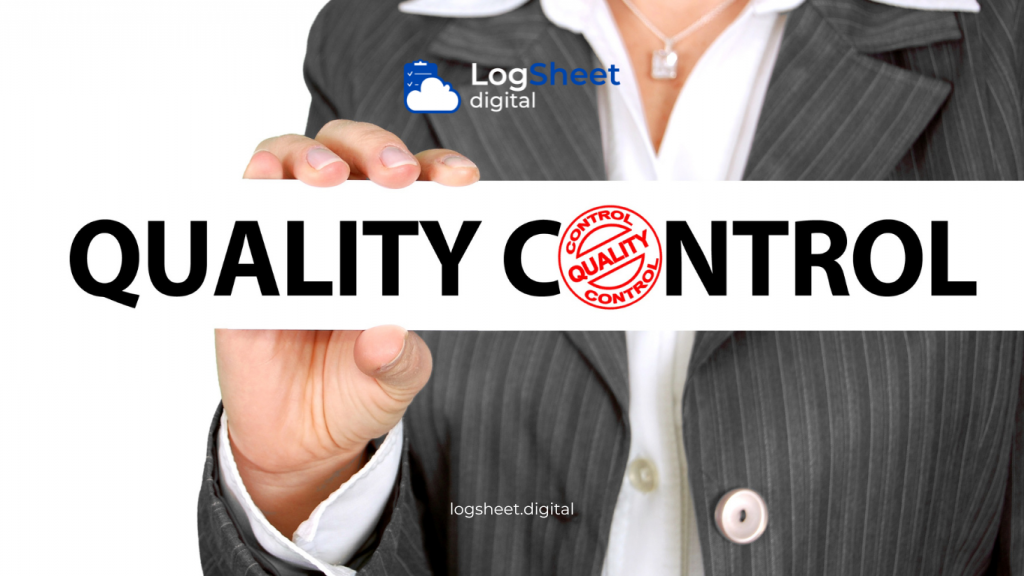Digitalization of industry has brought significant changes in the way companies run their businesses, particularly in terms of quality control. One of the technologies that is becoming increasingly popular is the digital logsheet. With digital logsheets, quality data can be accessed in real-time and managed more efficiently, creating a more effective and connected quality control system. This article will discuss the importance of digital logsheets in supporting better and more integrated quality control.
1. Understanding Digital Logsheets and Their Benefits in Industry

Read More: Digital Logsheet as a Real-time Monitoring Tool in Production Operations
What is a Digital Logsheet?
A digital logsheet is a system for recording operational and quality data automatically using software. Unlike conventional methods, a digital logsheet eliminates the need for manual documentation, which is prone to errors and time-consuming.
Key Benefits of Using Digital Logsheets
Using digital logsheets offers various benefits that support production efficiency and quality, such as:
- Real-Time Recording: Data can be collected and accessed instantly, allowing for early problem detection.
- Minimizing Human Errors: Reducing manual entry helps minimize the risk of errors.
- Quick and Easy Data Access: Centralized data that is easy to access anytime.
- Cost and Time Savings: Reduces the time needed for manual data entry and processing.
2. The Importance of Connected Quality Control in Modern Industry

Read More: Digital Logsheet for Machine Performance Monitoring in Operations
What is Connected Quality Control?
Connected quality control is an approach where all relevant departments can access and monitor quality directly and collaboratively. This system allows for faster, more informed decision-making.
Why is Connected Quality Control Necessary?
In the face of intense competition, companies must maintain quality standards to stay relevant and competitive. With connected quality control, companies can ensure that every production unit meets standards, regardless of time or location, boosting productivity and the final product quality.
3. Steps to Implement Digital Logsheets in Quality Control

Read More: Digital Logsheets for Planned Operation Quality Monitoring
To ensure successful implementation of digital logsheets, companies need to follow several important steps:
a. Evaluate and Prepare Technological Infrastructure
Implementing digital logsheets requires adequate technology infrastructure. Companies should evaluate the availability of hardware and networks that support the system.
b. Choose the Right Software
Selecting the right logsheet software that aligns with the company’s needs is crucial. Features to consider include real-time data capture, integration with other devices, data security, and compatibility with existing management systems.
c. Employee Training
The adoption of new technology requires adaptation and training for employees. A training program should be implemented so that employees understand how to operate digital logsheets and the benefits of this technology.
d. Integration wite. Continuous Monitoring and Evaluation
Companies must regularly evaluate the use of digital logsheets. This monitoring helps identify areas for improvement and ensures the system functions optimally for quality control purposes.
4. Challenges in Implementing Digital Logsheets in Industry

Read More: Digital Logsheets as a Real-time Monitoring Tool in Workshop Operations and Maintenance
a. Employee Readiness and Adaptation
Not all employees have the skills or experience to use digital logsheets. This can pose a challenge, especially for production teams who may be more familiar with manual methods.
b. High Initial Investment
Implementing digital logsheets requires initial costs for purchasing software, infrastructure, and training. This can be a challenge for companies with limited budgets.
c. Integration with Existing Systems
Integrating digital logsheets with existing legacy systems can be a technical challenge, particularly if those systems were not designed for data synchronization.
d. Data Security
The data stored in digital logsheets needs to be protected from cyberattacks or unauthorized access. Therefore, companies must pay attention to data security measures to safeguard sensitive information.
5. Digital Logsheets in the Context of Connected Quality Control: Case Study

Read More: Optimize Performance with Digital Logsheets
Case Study: Implementation at XYZ Manufacturing Company
XYZ Company, operating in the automotive industry, has implemented digital logsheets for quality control in production. Before implementation, the company often faced issues with quality discrepancies that were detected late due to manual logging.
With digital logsheets, quality data is automatically recorded at each stage of production. The quality control team can view data in real-time and identify patterns of discrepancies. As a result, the company managed to reduce defective products by 20% within a year.
Analysis of Success
The implementation was considered successful due to the following reasons:
- Faster Problem Detection: Digital logsheets enabled the team to detect discrepancies quickly.
- Improved Collaboration: All departments had access to quality data, enabling more effective responses.
- Cost Savings: Reduced defective products that could incur additional costs.
6. The Impact of Digital Logsheets on Audit Processes and Compliance

Read More: Smart Solutions: Digital Logsheets for Operational Health
Facilitating Internal and External Audit Preparation
Digital logsheets store all quality data systematically, making the company more prepared for audits. Automatically recorded data also helps the company comply with quality regulatory standards.
Improving Compliance with Industry Standards
With automated, well-organized record-keeping, digital logsheets make it easier for companies to comply with industry standards such as ISO 9001. This compliance can enhance the company’s reputation among customers and stakeholders.
7. The Future of Quality Control with Digital Logsheets and Advanced Technologies

Read More: Data Security in Digital Logsheets: Challenges and Calibration Strategies
Integration with the Internet of Things (IoT)
The future use of IoT will enable digital logsheets to connect with sensors and other production devices. As a result, quality data can be directly collected from machines and monitored in real-time without human intervention.
Utilizing Artificiaer Data Security
Blockchain can be utilized to store logsheet data more securely. In fact, this technology ensures that the data remains immutable, meaning it cannot be altered or tampered with. As a result, it significantly enhances both the transparency and reliability of quality data records, providing a more trustworthy foundation for decision-making and audits.
Conclusion

Read More: Digital Logsheet Implementation in Asset Security Monitoring
The implementation of digital logsheets as a foundation for connected quality control offers numerous benefits for companies, improving efficiency, data accuracy, and responsiveness to quality changes. Despite challenges such as employee readiness and initial costs, the long-term impact on quality improvement is significant.
With the continued advancement of technology, the future of quality control through digital logsheets will be strengthened by advanced technologies such as IoT, AI, and blockchain. This transformation not only changes how companies manage quality but also opens up great opportunities to create a more connected, transparent, and reliable industrial ecosystem.






comments (0)